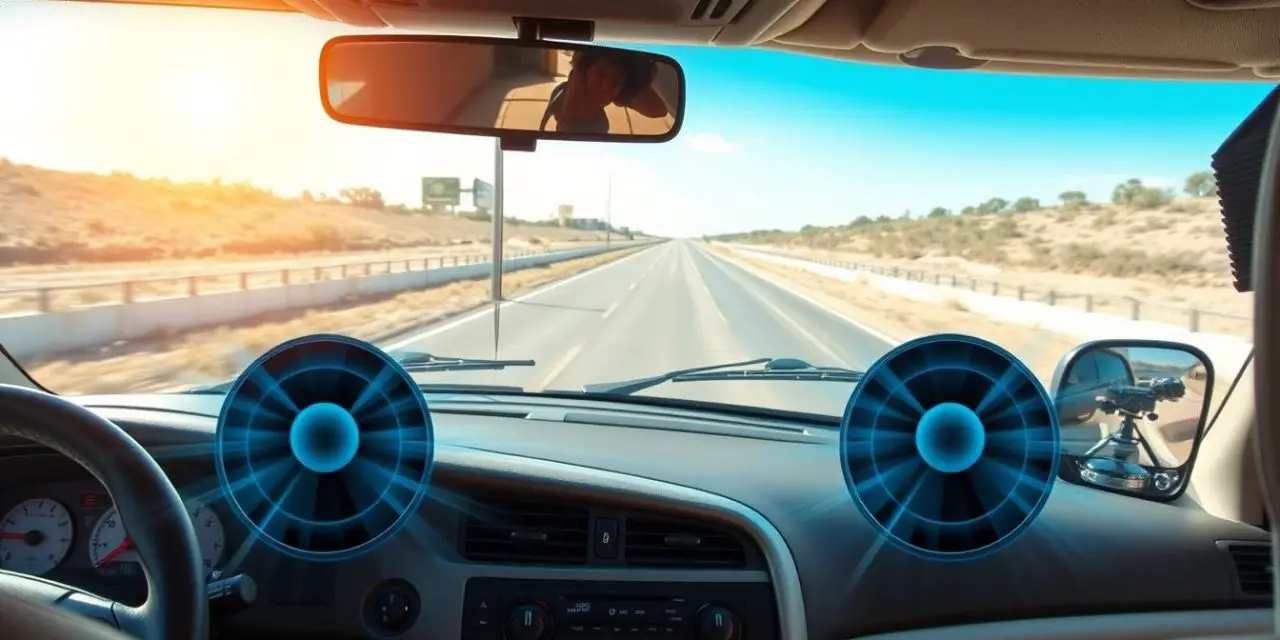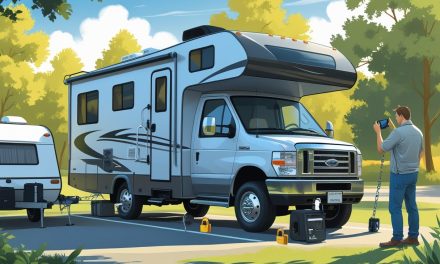Would you like to save this article?
If you’re planning a road trip in your recreational vehicle, especially during hot summer months, you might be wondering: can you drive an RV with the generator on? The short answer is yes—you can typically run your RV generator while driving, as long as it’s a built-in generator. However, there are important safety considerations, potential benefits, and a few drawbacks you should understand before hitting the road with your generator humming.
In this comprehensive guide, we’ll explore everything you need to know about operating your generator while traveling, from manufacturer recommendations to fuel efficiency impacts and alternative power solutions.
Safety Considerations When Running Your Generator While Driving
Regular safety inspections are essential when operating your generator while driving
Before you decide to run your generator while driving RV with generator on, it’s crucial to understand the safety implications and manufacturer guidelines.
Manufacturer Recommendations
Most RV manufacturers design built-in generators to be safely operated while the vehicle is in motion. However, this isn’t universal for all models and types. Here’s what you should check:
- Review your specific RV and generator owner’s manuals for any warnings or recommendations about generator operation while driving
- Confirm that your generator is properly mounted and secured according to manufacturer specifications
- Verify that all exhaust systems are functioning correctly to prevent carbon monoxide from entering the living space
- Ensure that your generator has undergone regular maintenance and is in good working condition
Carbon Monoxide Concerns
One of the most significant safety considerations is carbon monoxide (CO) exposure. Your generator produces this odorless, colorless gas that can be lethal in enclosed spaces.
Warning: Never operate a portable generator while driving. Only built-in generators with proper exhaust systems are designed for safe operation while the RV is in motion.
To minimize carbon monoxide risks:
- Install and maintain working carbon monoxide detectors in your RV
- Ensure all windows and vents near the generator exhaust are closed while driving
- If you detect any exhaust smell inside the RV while driving, turn off the generator immediately and investigate
Benefits and Risks of Running Your Generator While Driving
Benefits
- Ability to run rooftop air conditioning in hot weather
- Power for residential refrigerators that require 110V electricity
- Entertainment options for passengers (TV, gaming systems, etc.)
- Arriving at your destination with a pre-cooled RV
- Regular generator exercise, which is good for maintenance
- Ability to use microwave and other appliances while on the road
Risks
- Slightly reduced fuel efficiency
- Potential carbon monoxide hazards if equipment is faulty
- Additional noise while driving
- Possible restrictions in certain areas (tunnels, bridges)
- Increased wear on generator components
- Fire risk if generator malfunctions
Real-World Experience
Many RV owners regularly run their generators while driving without issues. As one experienced RVer shared, “In our 36′ class A living in Las Vegas, we have to run the generator during summer when going down the road as the dash A/C can’t remotely keep up and keep us and the dogs cool.”
Another RVer noted, “We rarely use the generator so we figured to exercise the generator on an hour trip so the trailer would be cool when we got to the lake. Outside temps were 100°-102° so we figured we’d kill two birds with one stone. Worked very well.”
Impact on Fuel Efficiency
A common concern among RV owners is how running the generator affects fuel consumption. While there is some impact, it’s generally less significant than many people expect.
Most RV generators consume between 0.5 to 1 gallon of fuel per hour of operation, depending on the load and generator size.
To put this in perspective, if your RV gets 7 miles per gallon (a common figure for larger Class A motorhomes), and you’re traveling at 60 mph, you’re already using approximately 8.5 gallons of fuel per hour for the engine alone. Adding another 0.5-1 gallon per hour for the generator represents a relatively small percentage increase in overall fuel consumption.
Many modern RVs have a safety feature that automatically shuts off the generator when the fuel tank reaches one-quarter capacity, ensuring you have enough fuel to reach a service station.
| Generator Size | Approximate Fuel Consumption | Impact on 100-Mile Trip |
| 3,000-4,000 Watt | 0.3-0.5 gal/hour | Minimal (2-3% increase) |
| 5,000-6,000 Watt | 0.5-0.8 gal/hour | Small (3-5% increase) |
| 7,000+ Watt | 0.8-1.2 gal/hour | Moderate (5-7% increase) |
Proper Procedures for Generator Operation While Driving
Following the correct procedures when starting, operating, and stopping your generator while driving is essential for safety and equipment longevity.
Before Starting Your Trip
- Perform a visual inspection of your generator, checking for any loose connections, fuel leaks, or exhaust system damage
- Ensure your generator has adequate fuel (if separate from main tank) or that your main tank is sufficiently full
- Verify that all carbon monoxide detectors in your RV are functioning properly
- Check that the generator compartment is free from debris and properly ventilated
Starting the Generator While Driving
If you decide to start your generator after you’re already on the road:
- Ensure you’re on a straight, level section of road with minimal traffic
- Have a passenger start the generator if possible, rather than attempting to do so while driving
- If driving alone, consider pulling over to a safe location to start the generator
- Once started, monitor for any unusual sounds, smells, or warning lights
Shutting Down the Generator
When it’s time to turn off your generator:
- Turn off any high-draw appliances (air conditioners, microwaves) before shutting down the generator
- Allow the generator to run without load for 3-5 minutes to cool down
- Follow the manufacturer’s recommended shutdown procedure
- If possible, shut down the generator before entering tunnels, enclosed spaces, or areas where generator use may be restricted
Common Scenarios for Running Your Generator While Driving
There are several common situations where RV owners typically choose to run their generators while driving:
Hot Weather Travel
The most common reason to run a generator while driving is to power the rooftop air conditioner(s). The dash air conditioning in most RVs isn’t powerful enough to cool the entire living space, especially in larger motorhomes. Running the generator allows you to maintain a comfortable temperature throughout your RV, which is particularly important if you have passengers or pets in the living area.
Powering Residential Refrigerators
Many newer RVs come equipped with residential-style refrigerators that require 110V power to operate. While some RVs have inverters that can power these appliances from the house batteries while driving, others may need the generator to keep the refrigerator running on longer trips.
Entertainment for Passengers
On long journeys, passengers in the living area might want to watch TV, use gaming systems, or operate other entertainment devices that require more power than the inverter can provide. Running the generator makes this possible.
Pre-Cooling Before Arrival
Many RVers start their generators an hour or so before reaching their destination to pre-cool the RV. This is especially helpful when arriving at a campsite during hot weather, allowing for a more comfortable setup experience.
Legal and Insurance Considerations
Before operating your generator while driving, it’s important to understand any legal restrictions or insurance implications that might apply.
State and Local Regulations
While there are no federal laws specifically prohibiting running an RV generator while driving, some states and localities have restrictions that may apply:
- Noise ordinances in certain areas may restrict generator use
- Some tunnels, bridges, and enclosed roadways prohibit the use of propane appliances, which may include propane-powered generators
- National parks and other protected areas may have specific rules about generator operation
Insurance Implications
Most RV insurance policies don’t specifically address generator operation while driving. However, if a generator malfunction leads to an accident or damage, your coverage might be affected if:
- You were operating the generator contrary to manufacturer recommendations
- The generator wasn’t properly maintained according to the maintenance schedule
- You were aware of a pre-existing issue with the generator but continued to use it
It’s always a good idea to contact your insurance provider to clarify their position on generator operation while driving before making it a regular practice.
Maintenance Considerations for Generators Used During Travel
Generators that are frequently used while driving require special attention to maintenance:
- Check oil levels more frequently, as operation on moving/vibrating surfaces can increase oil consumption
- Inspect mounting hardware regularly to ensure the generator remains securely attached
- Clean or replace air filters more often, as driving can introduce more dust and debris
- Monitor for any unusual noises or performance changes that might indicate problems
- Follow the manufacturer’s maintenance schedule, but consider more frequent service intervals for heavily used generators
Many RV owners report that regular use of the generator, including while driving, can actually be beneficial for the equipment. As one experienced RVer noted, “It’s always a good idea to exercise the generator. Good idea killing two birds with one stone!”
Alternative Power Solutions for RVers
If you’re concerned about running your generator while driving, or if you’d like to reduce your reliance on it, several alternative power solutions are available:
Enhanced Battery Systems
Installing a larger battery bank, particularly lithium batteries, can provide more power while driving without needing the generator. As one RVer shared, “I put in 810amp hrs worth of Lithium batteries and a 3000 watt 120vx2 inverter. Now we switch on the A/C for the last tank of gas arriving with a cool RV.”
Solar Power Systems
While solar panels won’t typically generate enough power to run air conditioners, they can help maintain battery charge for other appliances and reduce generator runtime.
Upgraded Alternators
Some RVers install high-output alternators that can charge house batteries more effectively while driving, providing more power for inverters to run 110V appliances.
DC-Powered Alternatives
Consider replacing some 110V appliances with 12V DC versions that can run directly from your house batteries without requiring an inverter or generator.
Final Thoughts on Running Your RV Generator While Driving
Running your RV generator while driving is generally safe and practical when done correctly. For many RVers, especially those traveling in hot weather or with residential refrigerators, it’s an essential part of the journey that enhances comfort and convenience.
The key takeaways to remember are:
- Always follow manufacturer recommendations for your specific RV and generator
- Maintain your generator properly and inspect it regularly
- Be aware of the slight increase in fuel consumption
- Consider alternative power solutions if they better suit your needs
- Monitor for any signs of problems and address them promptly
By understanding the considerations outlined in this guide, you can make an informed decision about whether running your generator while driving is right for your RV lifestyle.







